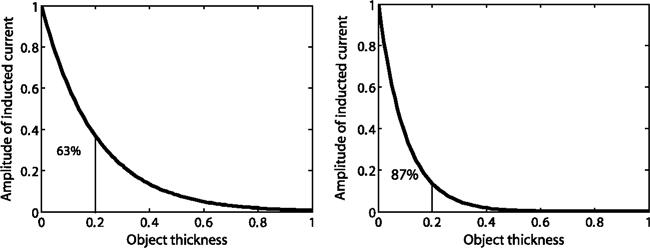I.2. Characteristics
A general characteristic of induction heating is the non-uniform power distribution in the thickness of the material to be heated. This phenomenon, known as the skin effect, arises from the fact that the inducted currents create fields opposed to the source fields, and leave the object’s core to “group” in a zone known as the skin depth. In this layer near the material’s surface, 63% of the inducted currents and 87% of the generated power are concentrated (Figure I.2).
Figure I.2. Skin depth

The skin depth can be deduced from Maxwell’s equations. For a semi-infinite plate, it is given by:
[[I.1]] 
where ![]() is the magnetic permeability of the object to be heated (H.m−1),
is the magnetic permeability of the object to be heated (H.m−1), ![]() is its electric conductivity (
is its electric conductivity (![]() .m)−1, and
.m)−1, and ![]() is the frequency of the induction generator. Of these three parameters, only the frequency can be modified by the user. Therefore, the frequency is a tool to change the skin depth.
is the frequency of the induction generator. Of these three parameters, only the frequency can be modified by the user. Therefore, the frequency is a tool to change the skin depth.
For a given material and a given type of heating, the skin depth is the most important parameter for defining the heating frequency. Thus, melting steel (i.e. heating a volume of a conductive, ferromagnetic material) requires weak frequencies, of the order of a few kHz. But, to maintain an inductive plasma at 10,000 K, greater frequencies of the order of a few MHz are required. Table I.1 groups skin depth as a function of frequency for some materials traditionally heated by induction.
Table I.1. Skin depth of various materials

